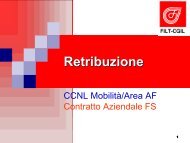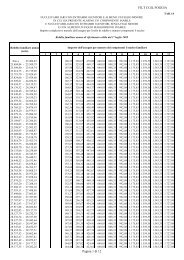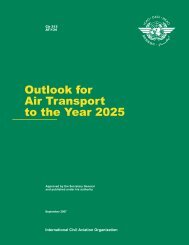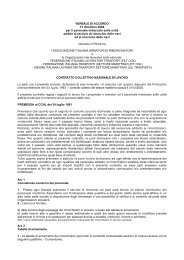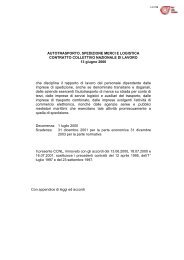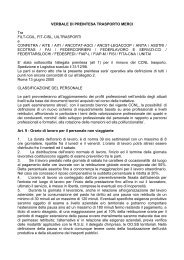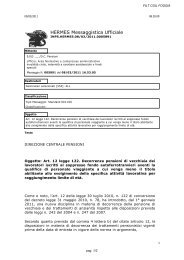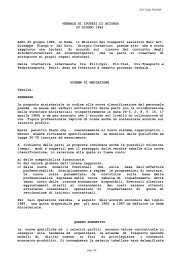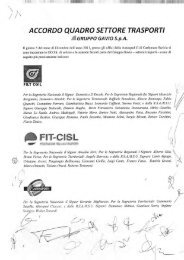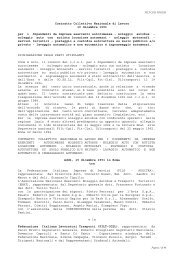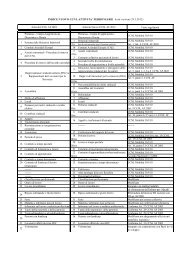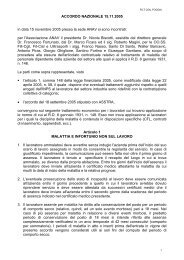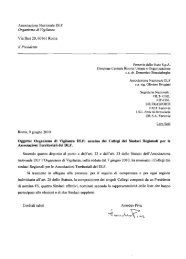Outlook for Air Transport to the Year 2015 - FILT CGIL Foggia
Outlook for Air Transport to the Year 2015 - FILT CGIL Foggia
Outlook for Air Transport to the Year 2015 - FILT CGIL Foggia
Create successful ePaper yourself
Turn your PDF publications into a flip-book with our unique Google optimized e-Paper software.
Chapter 2. <strong>Air</strong> <strong>Transport</strong> Trends and Challenges 1946. Within <strong>the</strong> EU, <strong>the</strong>re was a significant development creating a new negotiating dynamic involving airservices agreements by third parties with <strong>the</strong> EU member States, following <strong>the</strong> judgements of <strong>the</strong> European Cour<strong>to</strong>f Justice in November 2002, which ruled against certain provisions in some EU members’ open skiesagreements with <strong>the</strong> United States. In June 2003, <strong>the</strong> Council of <strong>the</strong> European Union conferred on <strong>the</strong> EuropeanCommission a mandate <strong>to</strong> negotiate air services agreements on behalf of all member States with <strong>the</strong> United States<strong>for</strong> creation of an Open Aviation Area (OAA) between <strong>the</strong> two terri<strong>to</strong>ries, as well as <strong>to</strong> negotiate with certainthird countries on <strong>the</strong> replacement of certain specific provisions in <strong>the</strong> existing agreements.47. At <strong>the</strong> multilateral level, <strong>the</strong> World Trade Organization (WTO-OMC) came in<strong>to</strong> being in January 1995and <strong>the</strong> General Agreement on Trade in Services (GATS) entered in<strong>to</strong> <strong>for</strong>ce. The GATS Annex on <strong>Air</strong> <strong>Transport</strong>Services applies trade rules and principles such as most-favoured nation (MFN) treatment and national treatment<strong>to</strong> three specific so-called “soft” rights, namely, aircraft repair and maintenance, selling and marketing of airtransport, and computer reservation system (CRS) services. It excludes from <strong>the</strong> application of <strong>the</strong> GATS“services directly related <strong>to</strong> <strong>the</strong> exercise of traffic rights”. Pursuant <strong>to</strong> an earlier ministerial decision, <strong>the</strong>WTO-OMC launched in 2000 <strong>the</strong> first review of <strong>the</strong> operation of this Annex with a view <strong>to</strong> considering possibleextension of its coverage in this sec<strong>to</strong>r. In 2003, however, <strong>the</strong> first review was concluded with <strong>the</strong> result that <strong>the</strong>Annex remains unchanged, and <strong>the</strong> next review would commence <strong>to</strong>wards <strong>the</strong> end of 2005.48. O<strong>the</strong>r more general regula<strong>to</strong>ry measures also affect air transport. Such measures include competition law,<strong>the</strong> imposition of various taxes, <strong>the</strong> expansion of airline responsibilities associated with national entryrequirements (particularly <strong>for</strong> inadmissible passengers), more stringent health standards <strong>for</strong> entry particularlywhere prevention of <strong>the</strong> spread of Acquired Immune Deficiency Syndrome (AIDS) and Severe Acute Respira<strong>to</strong>rySyndrome (SARS) is sought, and national narcotics control ef<strong>for</strong>ts.INDUSTRY STRUCTURE49. Traditionally, changes in airline industry structure arise from <strong>the</strong> need <strong>to</strong> meet growing demand <strong>for</strong> airtransport services in increasingly competitive but less regulated markets and a more globalized economicenvironment.50. Mega-carriers in <strong>the</strong> United States and elsewhere operate out of <strong>the</strong>ir home base airports applying <strong>the</strong>“hub and spoke” system which employs large banks or complexes of interconnecting flights <strong>to</strong> maximize <strong>the</strong>number of city-pair markets that can be served by each flight. This operational approach arose from a perceivedneed <strong>to</strong> operate several hubs and <strong>to</strong> achieve critical mass (i.e. a size sufficient <strong>to</strong> exploit economies of scope anddensity, and <strong>the</strong> ability <strong>to</strong> influence market conditions). However, <strong>the</strong> hub-and-spoke concept has recently comeunder scrutiny as one of <strong>the</strong> measures taken by airlines <strong>to</strong> reduce airport services costs by utilizing staff, gates andaircraft more productively; <strong>for</strong> instance, American <strong>Air</strong>lines began <strong>to</strong> de-peak at its two hubs Dallas/Fort Worth(Texas) and Chicago O’Hare (Illinois).51. <strong>Air</strong>lines are making increased use of computer-based measures <strong>to</strong> improve productivity and optimizerevenues, including <strong>the</strong> use of au<strong>to</strong>mated systems <strong>for</strong> yield management and <strong>for</strong> marketing, sales andcommunication. First, <strong>the</strong> development of sophisticated yield management systems, associated with <strong>the</strong> use ofcomputers, has enabled airlines <strong>to</strong> adjust <strong>the</strong> mix of high- and low-fare passengers on each flight in order <strong>to</strong>maximize revenues as well as <strong>to</strong> allocate seats efficiently. Yield management has enabled established higher-costairlines in certain instances <strong>to</strong> compete selectively with new lower-cost airlines that are often reliant upon lowfares <strong>to</strong> achieve market penetration. Second, product distribution is now being carried out through CRS.




